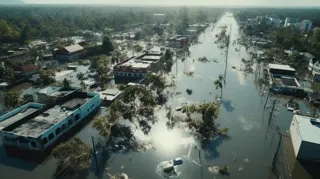Howrah Land Subsidence Crisis: Water and Power Outages Disrupt Thousands Amid Rehabilitation Efforts
 A catastrophic land subsidence in Howrah’s Belgachia area on March 21 has upended daily life for thousands of residents, crippling water and power supplies while raising urgent questions about urban infrastructure resilience. This unfolding crisis underscores vulnerabilities in waste management practices and disaster preparedness.
A catastrophic land subsidence in Howrah’s Belgachia area on March 21 has upended daily life for thousands of residents, crippling water and power supplies while raising urgent questions about urban infrastructure resilience. This unfolding crisis underscores vulnerabilities in waste management practices and disaster preparedness.
Overview of the Crisis
The subsidence occurred near a municipal landfill, cracking roads and destroying over 100 homes across a 1.5-square-kilometer area. Critical damage to infrastructure includes a 1-kilometer water pipeline supplying Shibpur and North Howrah suburbs. Engineers are racing to stabilize the ground while restoring basic services threatened by methane gas leaks detected at the site.
Displaced families now face a harsh choice: vacate unstable homes for temporary shelters or risk catastrophic structural collapse. Authorities have set up emergency accommodations at a local club, yet many residents persist in occupying precarious dwellings – demanding written guarantees for permanent housing before relocating.
Immediate Impacts on Residents
- Water shortages: Disrupted pipelines have left households dependent on municipal water tankers. Urban Development Minister Firhad Hakim acknowledged the crisis during a March 24 site visit, promising solutions within 72 hours.
- Power disruptions: Electrical grids remained unstable, exacerbating reliance on temporary water supplies.
- Health risks: Surging methane gas concentrations from decomposing waste heighten safety concerns for remaining occupants.
Government Response and Restoration Efforts
Relocation Plans
Authorities have proposed constructing new apartments for displaced families through urban redevelopment initiatives. Contractors are employing soil tests to determine potential bio-mining applications – a waste-to-fertilizer technique advocated by environmental experts as a sustainable alternative to traditional dumping.
Infrastructure Repairs
Engineers are prioritizing:
- Pipeline restoration for Howrah District
- Road reconstruction in damaged zones
- Methane gas leak containment systems
Meanwhile, political tensions flared during visits by opposition leaders Subhankar Sarkar (Congress) and Suvendu Adhikari (BJP), who accused state officials of inadequate preparedness despite prior warnings about landfill instability.
Challenges and Concerns
- Relocation resistance: Demand against legal safeguards before accepting temporary housing solutions
- Operational complexities: Bio-mining implementation requires specialized equipment not readily available locally
OFFICIAL RESPONSES TO THE CRISIS
| Agency | Action |
|---|---|
| Urban Development Department | Apologized for delays, coordinated with disaster management teams |
| Kolkata Municipal Corporation | Deployed water tankers, collaborated on road repairs |
| Ministry of Urban Affairs | Funded early-stage bio-mining feasibility studies |
Future Directions and Long-Term Solutions
Local administrators are contemplating a multi-pronged approach to prevent recurrence:
- Waste management reforms: Stricter landfill regulation and segregation protocols
- Geoengineering upgrades: Installing underground reinforcement systems in vulnerable zones
- Community engagement: Resident consultation units to ensure housing solutions meet displaced families' needs
As the Howrah situation shows, modern urban planning success hinges on proactive infrastructure maintenance and adaptive disaster response strategies. For developers eyeing similar risk-prone regions, this event signals the critical need for underground stability assessments and accessible emergency protocols.